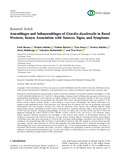Assemblages and Subassemblages of Giardia duodenalis in Rural Western, Kenya: Association with Sources, Signs, and Symptoms
Date
2024-02-05Author
Barasa, Erick
Indieka, Briston
Shaviya, Nathan
Osoro, Ezra
Maloba, Geofrey
Mukhongo, Denis
Budambula, Valentine
Were, Tom
Metadata
Show full item recordAbstract
Background. Giardia duodenalis causes sporadic or epidemic infections in humans. The parasite comprises assemblages A-H with A and B subdivided further into AI-IV and BI-IV subassemblages. Attempts aimed at linking these genotypes with sources and gastrointestinal manifestations of the infection are largely unexplored in rural communities. Methods. In this cross-sectional study, G. duodenalis infection was genotyped and associated with sources, and gastrointestinal signs and symptoms of the disease among residents of Busia County, a rural setting in western Kenya. Demographic and clinical information were captured using standardized forms. Stool specimens were obtained from the patients and used for genotyping at glutamate dehydrogenase and triose-phosphate isomerase loci using the polymerase chain reaction and restriction fragment length polymorphism. Results. Assemblage B (63.6%) was the most prevalent G. duodenalis infection, while A (20.5%) and mixed A/B (15.9%) were also detected. Among the subassemblages, AI (5.7%), AII (8.0%), AIII (3.4), BIII (30.7%), and BIV (17.0%) were diagnosed including the mixed AII/BIII (15.9%), BIII/BIV (15.9%), AI/AIII (2.3%), and AI/AII (1.1%) infections. Binary logistic regression indicated associations for assemblage A with stomach upset, history of nitroimidazole treatment, and residing in a homestead with cattle and B with years, history of eating outdoors, vomiting, steatorrhea, and residing in a homestead with cattle, goats, and poultry ( for all). Among the subassemblages, associations were found for AI with residing in a homestead having cattle and history of nitroimidazole treatment, BIII with residing in a homestead having cattle and poultry, and BIV with steatorrhea ( for all). Altogether, this study illustrates that G. duodenalis assemblage B and subassemblage BIII are the most predominant and are linked to years, gastrointestinal manifestations, and living in a homestead with domestic ruminants and poultry. Conclusion. Targeted mass prophylactic treatment of domestic animals and utilization of gastrointestinal presentations, years, and a history of nitroimidazole use are useful in the diagnosis and prevention of giardiasis among residents of rural communities.
URI
https://doi.org/10.1155/2024/1180217https://www.hindawi.com/journals/jpr/2024/1180217/
http://ir-library.mmust.ac.ke:8080/xmlui/handle/123456789/2630
Collections
- Gold Collection [1026]

